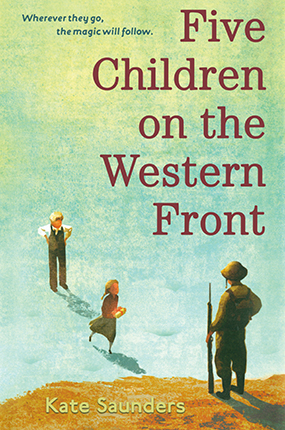| Five children on the Western Front Author: Saunders, Kate | ||
| Price: $6.50 | ||
Summary:
In 1914, on the eve of the First World War, Cyril is off to fight, Anthea is at art college, Robert is a Cambridge scholar, and Jane is at high school when the sand fairy, Psammead, suddenly reappears, and his magic has a more serious purpose than when the siblings were children.
| Added Entry - Personal Name: | Nesbit, E |
| Accelerated Reader Information: Interest Level: MG Reading Level: 5.40 Points: 9.0 Quiz: 183617 |
Reviews:
Kirkus Reviews (06/01/16)
School Library Journal (06/01/16)
Booklist (07/01/16)
The Bulletin of the Center for Children's Books (07/16)
The Hornbook (00/09/16)
Full Text Reviews:
School Library Journal - 06/01/2016 Gr 5–8—This continuation of E. Nesbit's "Five Children and It" is set 10 years after the original series ended, during World War I. The Psammead, the magical and ancient sand fairy who took the children on their original adventures, has returned without control of his magical powers, and the youngest children in the family, the Lamb and Edie, try to protect him from discovery. The Psammead's magic returns at intervals, with temporary wish fulfillment and travels through the past to understand why the Psammead lost his powers and how he can redeem himself. Their adventures include visits to both the battlefront and the home front, where the Great War's effects on families and roles for women are very clear. The war affects different members of the family, from the older brothers, who join the British Army, to one of their sisters, who works in a war hospital, to the younger children, who make efforts to help their family and older siblings. The human toll of warfare is clearly and realistically presented, and while some characters find happy resolutions, the family is changed forever. This story stands alone, but it may motivate readers to return to the original books. VERDICT A dramatic, heartrending look at World War I's far-reaching consequences for families and individuals. This book will appeal to both historical fiction and fantasy fans.—Beth L. Meister, Milwaukee Jewish Day School, WI - Copyright 2016 Publishers Weekly, Library Journal and/or School Library Journal used with permission.
Bulletin for the Center... - 07/01/2016 In Saunders’ homage and sequel to E. Nesbit’s Five Children and It, nine years have passed since the titular five children-Cyril, Anthea, Robert, Jane, and the Lamb-last saw the Psammead, the sand fairy, whose ability to grant wishes led to a series of whimsical adventures. He’s reappeared to a now eleven-year-old the Lamb and nine-year-old Edie, but his magic is gone and he’s weak and ailing. World War I preoccupies much of the elder children’s time: Cyril’s a lieutenant, Anthea’s a volunteer at the hospitals, and Robert will likely soon be conscripted, so it’s up to the two youngest to look after the cantankerous but loveable Psammead. As the events of the war unfold, however, so too does the Psammead’s backstory, and the parallels between his past misdeeds and the world’s current tragedies become painfully clear. Saunders strikes a surprisingly successful balance between the mischievous magic of the sand fairy and the harsh realities of wartime England. This tension plays out in the Psammead as well; the endearing, often comical grump is revealed to be a former desert god whose tyranny led to the death of thousands. When he’s not making droll comments about his current accommodations (in a tub full of sand in the children’s house) or wryly mocking the ways of humans, he’s looking for a way to repent for his past cruelty so he can move on, hopefully to a state of peace. The relationships between the siblings and their love for each other and for the Psammead are clearly delineated here, so readers need not be familiar with Nesbit’s original text, though a curious few might want to visit the children pre-war to gain a sense of the innocence lost. KQG - Copyright 2016 The Board of Trustees of the University of Illinois.
Booklist - 07/01/2016 Saunders pulls off a difficult feat here, taking up the narrative begun in E. Nesbit’s Five Children and It (1902) and concluded in The Story of the Amulet (1906), and continuing it for an audience in a different century. Although focused primarily on the years 1914 to 1919, the novel often references the adventures the older children had with the Psammead, a sand fairy whose magic includes wishes granted (though often gone awry) and travel through space and time. When 9-year-old Edie and her 11-year-old brother discover the seemingly legendary sand fairy, they look forward to adventures like the ones they’ve heard about in amusing family stories. But WWI casts a shadow over this close-knit family and even the Psammead himself, whose magic includes glimpses of the war and its effects. Strong portrayals of individual characters bring life and warmth to the story. With the four oldest siblings now actively engaged in the war effort, an entirely happy ending would have been unrealistic, but the novel offers a satisfying conclusion and a rewarding experience. - Copyright 2016 Booklist.



